-
4" To 6" Upgrade
@SLOPEmeisteR Have a look at the calcs page
I used it to calculate your heat up time for 380l with 15000W & got an answer of around 2.5 hours to get a 10% wash to 90C @ 90% efficiency.
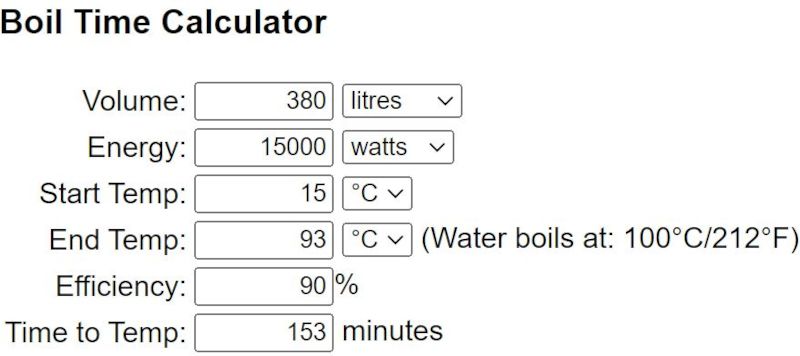
That page also has a vapour speed calculator ;-)
IMO the 380l is a perfect match with 8" columns. Remember diameter = speed. As a commercial operation, time = money. Smaller diameter = Longer runs = increased cost and lower production volumes :-(
I don't know why you say you can't get the power to run an 8". I have a 380l with 4 x 8" plates & use 21kw for heat up but cut back to 14kw for the run.
Good cuts come down to how you run the rig (eg power input, reflux ratio, timing, if you do a strip then spirit run etc). If you're going to be barrel aging you don't need the hearts cut to be as tight because you actually want a bunch of the congeners in heads (& late tails with rum) for flavour (but you won't get much of that on a sugar wash).
FYI, adding a few more plates will only take a little extra time to heat up. The longest time is getting the wash up to temp, getting the column to temp is pretty quick once the wash is boiling.
As you're operating in a pretty cold environment, don't forget you can insulate the boiler & column to improve thermal efficiency & hence overall performance of the rig.
The StillDragon User Group YouTube ChannelStillDragon visit to Copper Shot Distillery to review Steve's 4" continuous still performance
Continuous Column Stripping PlatesThat approach of using the threaded rod for the plate assembly is probably the most flexible way to R&D this.
For a long time, we were obsessed with capturing that plate in a way that prevented any leakage between the plate and the wall.
In this application, that gap is entirely manageable. Really, who cares. Sealing the plate to the column wall? Don't bother.
The physical downcomer tube limits flexibility though, I'd imagine you want to be able to easily vary the plate distance to find optimal performance - that's something that's impossible to do when you are using triclamp spool or tees.
I have a huge triclamp spool, 8" diameter, 10 feet long, a bunch of stainless threaded rod, and a bag of nuts and washers. I've been dying to get some time to hang a tree of plates like this.
Continuous Column Stripping PlatesGood day!
Just would like to share my experience, my present 6" column has 20 plates, 8mm holes with downcomers, finally downcomers pipes have been shorted (Pic #4) for better performance.
Previously I use to work on 4" column (last Pic) with 6mm and 8mm holes, just perforated plates without downcomers.
Actually it showed no difference in quality, depend of power (kwt) which you can supply to your steam generator.
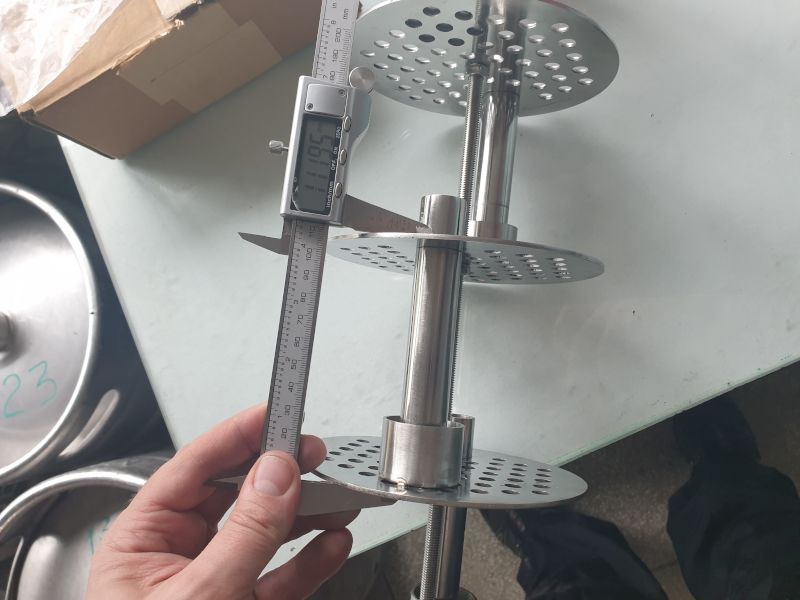
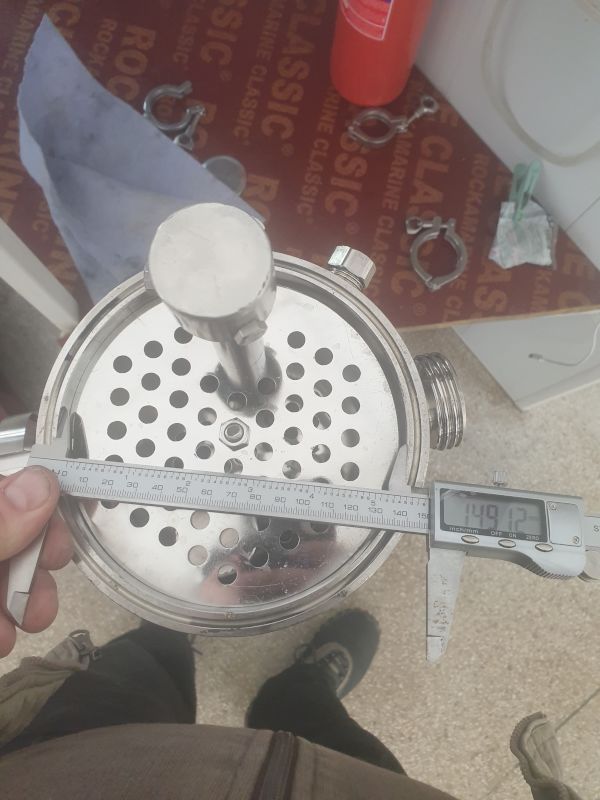
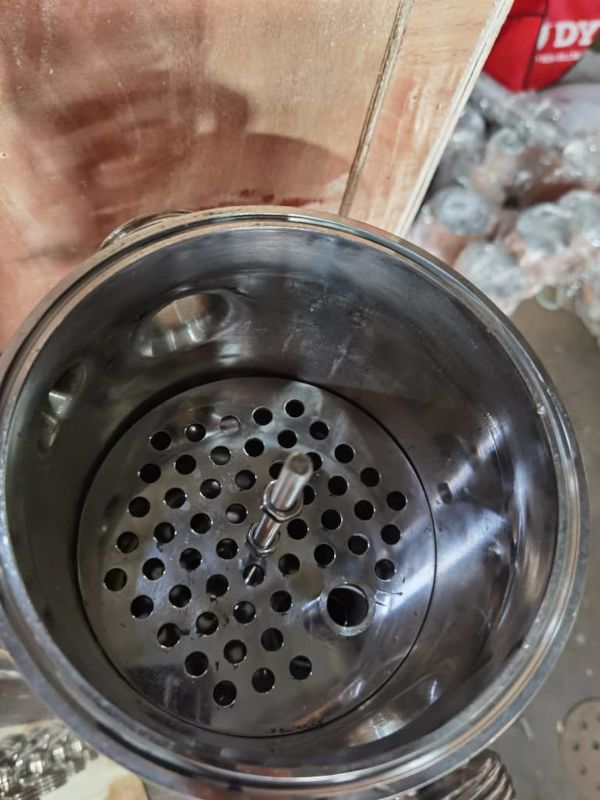
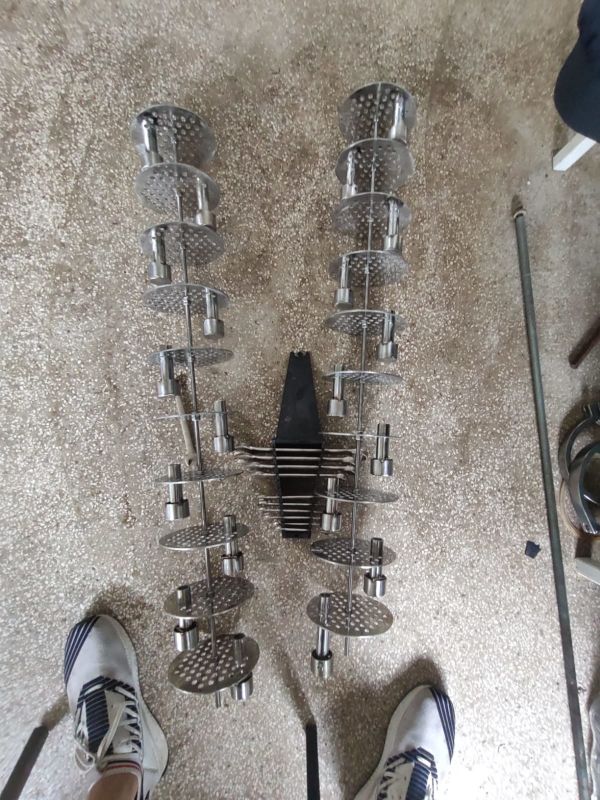
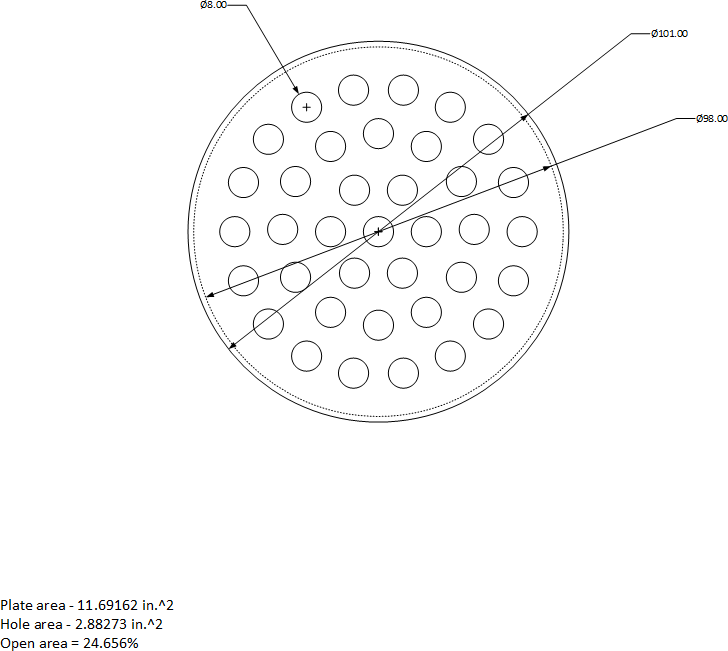
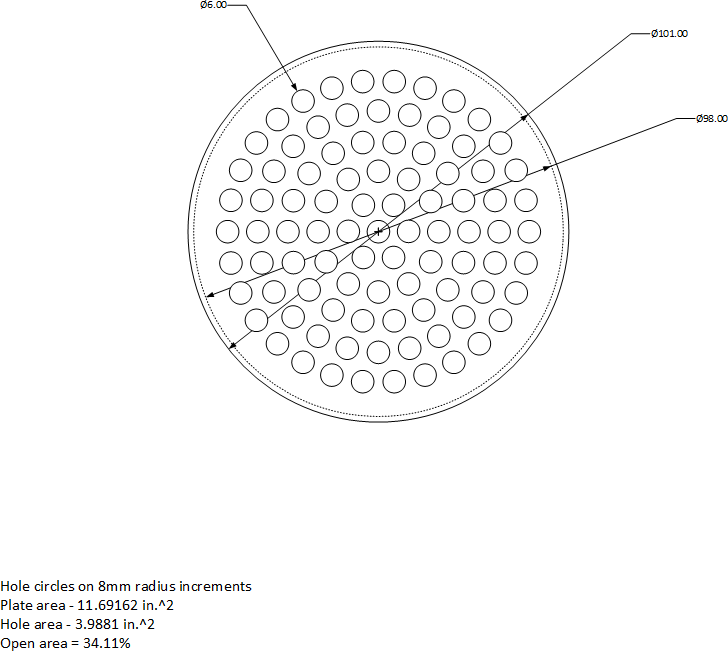
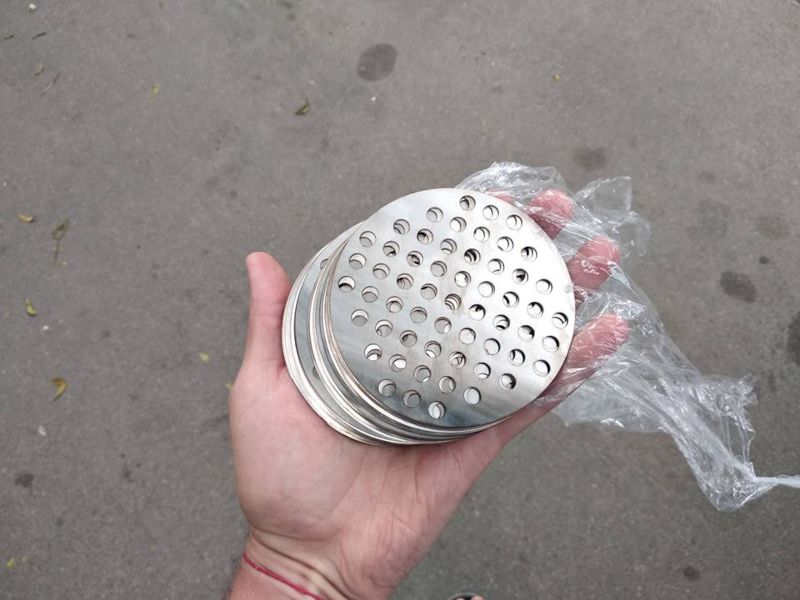
 Continuous Column Stripping Plates
Continuous Column Stripping Plates@Bolverk said: So the new plan is 24 holes spaced at 5/8" I'm going to start at 3/16" (4.7mm) with a 3/4 downcomer and just keep increasing the size of the holes until I get the performance I want. Based on what I've seen of the SD stripping plates I'm more inline with their design but I'm keep the holes a bit further apart to allow me to increase the hole sizes.
I feel like that should work nicely. If you don't have enough power to keep the plates loaded then simply fill a hole or two etc.
Continuous Column Stripping PlatesSo the new plan is 24 holes spaced at 5/8" I'm going to start at 3/16" (4.7mm) with a 3/4 downcomer and just keep increasing the size of the holes until I get the performance I want. Based on what I've seen of the SD stripping plates I'm more inline with their design but I'm keep the holes a bit further apart to allow me to increase the hole sizes.
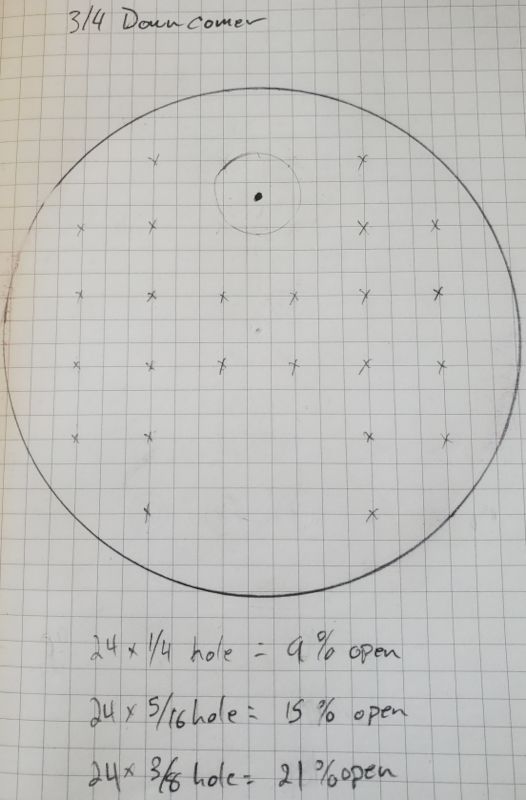 Continuous Column Stripping Plates
Continuous Column Stripping PlatesI bought some custom made 4" copper plates from SD and they have been working extremely well at up to 1.8 liter per minute ish feed rate in with wine at 13% alcohol ish and 30 to 55% alcohol out depending on how much power and antifoam I used. I don't know the % open you will have to check with Jeff and Larry. I have to review old logs to see that the alcohol volume out was , but that was early on before I really learned how to optimize with heat recovery and anitifoam. I will likely do some more work soon to see how I can optimize them and will share the results.
I moved on to an 8" stripper with 4 procap plates on double crystal dragon spacing and have been running 5 to 8 ish Liters per minute with 13% input and 71% alcohol output. It runs well but antifoam mixing is key to good performance
Dephlegmator With 3 x Inputs And 3 x Outputs - How To Plumb It?@grim said: It also allows you to use Grim's Crazy Alternative Condenser Plumbing Scheme.
Where there is a pump plumbed onto the condenser, circulating from the bottom to the top, separate from coolant input/output loop.
You can supercharge condenser performance with this approach, and more effectively use warmer water as your coolant.
I do not understand. I must be missing something.
Dephlegmator With 3 x Inputs And 3 x Outputs - How To Plumb It?It also allows you to use Grim's Crazy Alternative Condenser Plumbing Scheme.
Where there is a pump plumbed onto the condenser, circulating from the bottom to the top, separate from coolant input/output loop.
You can supercharge condenser performance with this approach, and more effectively use warmer water as your coolant.
ProCaps Are The Answer?!Off topic though, back to the original post.
On your point 7.
Not sure exactly what your doing to manage your reflux, but if you are just shutting a valve to half without the ability to monitor coolant temperature, you are going to have a hard time repeating runs, or dialing in the still for optimal performance. Odd plate flooding - for me this almost always feels like a subcooled reflux issue pushing the column out of equilibrium.
Power input is only one half of the equation, balanced by the reflux ratio on the top side. Flooding isn't about power input exclusively, the amount of reflux you are sending back down is the issue. ESPECIALLY, when you are sub-cooling to do it.
ProCaps Are The Answer?!Hi this is my first post so I wasn’t really sure if I should start my own thread or piggy back on to somebody else’s thread. Apologies for the lengthy post and if it is in the wrong place.
Not even sure if this is a question, statement, introduction or seeking confirmation. Some background first.
I have been using a 4” 4 bubble plate modular still for 8-10 months and whilst I am happy with the final product I feel like there is something not quite right with the process.
The gear:
- 4x4x3 Tees
- 50L boiler
- 2 x 2400W elements
- Power controller
- Gate valves on outlets of defleg / PC
- Parrot
I predominantly run rum (sometimes a whiskey) as a single run. No stripping just run it slowly and take tight cuts. The product then goes on oak for 6 months.
On heat up I run both elements defleg open, once at temp I will drop 1 element to 35-40% and slowly take off fores. Once fores taken I will gradually close defleg to ½. At this setting I will have a take-off approx 2L /hr, so not quite the toothpick stream I have seen mentioned all over the net. Initially I was happy with that – it is a big step up from my 2” homemade pot with multiple strips then spirit run. Now I want to speed things up a bit. If I try push the 2nd element higher I get flooding on the 2nd &/or 3rd plate.
Now the reason I am here, after reading a lot about ProCaps and how it fixes flooding, I managed to get a 2nd hand set from oldmate on gumtree. I ran a sac run last weekend and wow I was able to run both elements at 100% and they wouldn’t flood, not even close (but y’all already knew that). I was squealing like a school girl at a Bieber concert. I did eventually dial the elements down to my normal power settings to see how it compared to the bubble plates. It was a definite improvement but not mind blowing 4-5L like some suggest.
Looks like I need to re-learn my still’s sweet spot. Obviously there is a lot of factors at play but i did read somewhere a figure of 1500w per cap.
- In theory run 4500W for the 4” plate with 3 caps. At these numbers what am I likely to get?
- Is this a guide for best power efficiency? Hydraulic performance? something else?
- Best or highest take-off rate without flooding plates during a longer run?
- Best or highest take-off rate without smearing the product?
- Because they can handle more power do I have to run them at the higher power?
- If 1500W per cap is the optimum / maximum rate what is the minimum if I wanted to run the still slowly. I am guessing the lowest power I can go to without stopping the bubbling?!
- Is there something else from what I have or haven’t mentioned which you think might need tweaking to give a better experience?
Thanks Swampy.
3 Chamber Still@grim said: Influence of sodium chloride on wine yeast fermentation performance @ Dovepress
Oh for heavens sake. I never would have thought that.
3 Chamber StillThermodynamic Properties Of Sugar WashI believe what Punkin is recommending is that it's likely best to determine these figures yourself through direct experimentation with the actual input products you'll be working with, as small errors in enthalpy constants can have a big difference in real world vs. theoretical performance.
And snakes.
Detune For FlavourFor single pass we’ve found best performance to run reflux at startup, take heads off at about 180-185pf, cut back reflux when you transition to hearts, and start adding back reflux as you approach tails.
Hearts reflux ratio will let you dial in flavor.
However, you’ll need to vary your cut points using this method, because if you cut for clean hearts, you’ll still end up with a lighter overall spirit, even if you cut off reflux through hearts. So think dirty cuts. It’s misleading because you are concentrating heads and tails by increasing reflux.
This gives you best of both worlds - single pass flavor profile, but with the yield improvement of strip/spirit.
Removing Sulphur ByproductsI played around with copper sulphate a bit.
What I found was best performance was found when you could rack off the precipitate. Meaning - using it on the strip, and not the base wash, and racking before doing the spirit run.
It’s easy to run dosage trials on small samples of strip, then just scale up once you figure out how many mg/l you need.
This should be considered a rescue operation, and not standard practice.
Stumpys Distillery ProcessHi,
Just wondering if anyone knows if the continuous stripping column in the stumpys video uses bubble caps or perforated plates and weird. He pumps in what seems to be unfiltered wash.
I would think there is a possibility of trapping and reducing the performance of the column if bits if grain from the wash are trapped under the bubble caps?
Would this be the case?
What type of plate is used?
Thanks,
HighlanderRTD vs ThermocoupleHello...
I know Im probably going to get beat up on this, but here is my 2 cents worth from and old electrical engineer that cut my teeth on both RTD and T/C.
Im an automation/controls/instrumentation integrator in West Palm Beach, Florida with over 40 years experience. To begin with...you can get very good performance from both an RTD or a Thermocouple. I have many customers that prefer one over the other and both swear that their choice is the best. I never argue, I just put in what they request. :) But I can tell you that after going to many of their locations and observing their applications, I understand why both sides make the claims that "their choice" is the best.
Most comes down to familiarity and maintenance (or lack of) and the initial installation.
I won't bore you with all the specs of the different types of both (but if you want you can email me with any question you might have on PLC, VFD, HMI, Instrumentation, etc. and I will reply with what has "worked" for me for many years). I will caution you not to get too hung up on the specs tho as these are all acquired in a laboratory environment which is never the real world and can never be duplicated.
Routing of the device wiring near high voltage wires is a constant concern, and non-grounded or poorly grounded equipment can add to your misreads and frustrations. Cheap controllers and cheap wiring also are a persons worst enemy regardless of the type of device you choose.
What I will tell you is a good quality Thermocouple installed correctly and maintained, will far outlast any RTD and give you the most consistent repeatability, and is far less prone to noise induced issues that can plague many RTD's. My people install both on a daily basis , but they ALL prefer to install a T/C due to its simplistic installation and no warranty call outs. Mush simpler to understand, maintain and troubleshoot.
I also have heard people talk about "Calibration" of these devices and just so we are clear, there is NO calibration of any temperature device, you can only VERIFY how close it is and compensate for the amount it is off in your controller.
I would also recommend that for example IF you are using a type J thermocouple that you verify it with a type K thermocouple. This will give you a more reliable comparison. Also, take advantage of the test terminal blocks that OMEGA offers, it will make your life less frustrating. Make sure you check connections on a regular basis.
Thermocouples also respond to temperature changes more effectively and will recover from fast changes more quickly.
I will end my comment that we also offer aircraft part heat treating equipment calibration services for several airlines and this is all an FAA required test using Type K and Type S thermocouples.
Im not trying to promote OMEGA Engineering but they do have some very good easy to understand and useful charts on thermocouple types, and offer many parts.Also, many times when we go out on service calls of people complaining about their RTD or Thermocouple, what we find is that its not the device that's the problem but the configuration setup of their controller that's the problem. SO always make sure your controller is configured and setup correctly for whatever device type you are using and your results will become a lot less frustrating, and invest in a few fairly inexpensive pieces of test meters like Fluke or whatever you like. Process of elimination is still the best method I have found to troubleshoot many issues.
Well...I know this was a little long, but I hope this helps. IF you want more specific details, or have more specific questions, please feel free to contact me.
Ester formation in the column stillDriving Fischer esterification in the still via extended duration refluxing is going to see better performance if you use a mineral acid catalyst. Typically, Sulfuric Acid is used in the lab, and if you read the old rum literature, you'll see it commonly referenced in high ester and heavy rum production. While other acids (citric, malic, etc), will not have the same impact as sulfuric, there is a lesser impact of increasing acidity generating/preserving more esters.
Keep in mind that there is a little bit of a balance here. While extended duration refluxing will create more esters, more plates will concentrate those esters more tightly than fewer plates will (smear). Extended refluxing, combined with a big heads cut - is somewhat counterproductive.
If you are stripping first, extended refluxing may also be counterproductive, depending on how deep your strip has gone. If you don't have the heavy alcohols, and carboxylic acids - you are only going to create lots ethyl acetate - which isn't a positive. (This is because you'll likely have lots of acetic acid and ethanol in a "tight" strip).
What is your favorite method of proofing your spirits?@Scottystraub - Please can you explain what you mean? I'm not sure how temp charts are connected to reverse osmosis water treatment. Thanks
@DonMateo - I think you're right. I need to go RO for my new distillery shortly. I don't know if RO's removal of Ca and Mg (for example) will be a problem for optimal performance of rum fermentation? The guys at AquaCure (link to the RO system is on my previous post) said that I can re-introduce certain ions following removal by RO with an additional "re-ionizer".
Does anyone know if re-ionizers are necessary following RO treatment please? It doubles the prices to go for both, so I want to make sure re-ionizing is worthwhile if I invest the money. Many thanks



